Introduction / History
Before The Birth
Remember the CB craze? From nothing in 1970 to over 20% of the corporate business in the early 70’s, CB radios not only contributed to Tandy’s profits, but brought an entire new group of customers into Radio Shack stores. Indeed, things were so good in electronics that Tandy Corp. sold off all its other subsidiaries including the original, Tandy Leather, in 1975. But the abrupt collapse of the CB craze in 1977 left the company in disarray.
Enter Don French and John Roach. Roach had joined Tandy in 1967 as a data processing manager and, by 1976 had been promoted to vice president of manufacturing. Don French was on the West Coast in the heart of Silicon Valley and had been trying to get Radio Shack involved in computers, even though his boss, Bernie Appel (recently promoted to president) was opposed. In mid-76, Roach and French were traveling together on the West Coast and stopped in to see National Semiconductor’s new SC/MP microprocessor. While there, they met Steve Leininger who briefed them on the hardware and software. Roach and French were impressed with Leininger and wanted to hire him to do some consulting. However, the National Semi marketing people refused to part with Leininger’s address or phone. Next stop on the itinerary of Roach and French was Paul Terrell’s Byte Shop on El Camino Real. What a surprise when they found Leininger moonlighting there as the night sales clerk. They asked him about consulting, but four weeks later asked him to come down to Ft. Worth to see the facilities.
At the end of the day, Roach offered him a job on the spot. Leininger accepted but found that Tandy wasn’t really committed to a computer just yet. For six months he, in his words, “played around with a couple of things-an audio pre-amp, a computer kit, and some other minor projects.” But as CB turned more and more sour, there was a growing cry at Tandy for something new. They finally moved Leininger off into a room of his own with instructions to build a computer. Leininger remembers it well, “It was there that I wire-wrapped the predecessor of the Model 1. I even put Tiny Basic with the graphics extensions in a 2K ROM.” (Tiny Basic was written by Dr. Wang at Stanford and placed in the public domain. Leininger had helped implement it for People’s Computer Company.
The Birth
The first ‘Tandy’ computer was the Radio Shack (TRS – Tandy Radio Shack) TRS-80. Called just the TRS-80, it later became known as the “Model I” when the TRS-80 Model II was announced in the summer of 1979.
The Model I was invented by Don French (A buyer for Tandy) & Steve Leininger (The head of the Homebrew Computer Association) and first announced on Wednesday, August 3, 1977, in Radio Shack Press Release 7741-A, at a press conference at the Warwick Hotel in New York City.
Radio Shack said they anticipated deliveries to start in two weeks, but was quite unsure of the product, thinking that they might sell 600 to 1000 the first year. It was also the most expensive single item Radio Shack had ever carried to that date. They required a $100 deposit to place the computer on order. In actuality 10,000 units were sold in the first month! Radio Shack was swamped with orders, and delivery times quickly fell to months after order. By early November of 1977, Radio Shack was delivering 16K RAM units with 5 digit serial numbers that had been ordered in early September. At that time, there were separate serial number sequences for 4K and 16K machines.
The Model I began with a $599 Level I System with 4K RAM, monitor, and cassette, with all cables and adapters ready to go (except that it took 3 plugs, so you probably needed to purchase a power strip). The Level 1 was soon replaced by a 16K Level II System. The Level II (first model) was updated to include a numeric keypad.
The Evolution
Soon after Level II showed up the Expansion Interface was made available for $299. The Expansion Interface had room for an additional 2 banks of 16K RAM and an RS-232 card. In addition the Expansion Interface already contained a floppy disk controller and a control circuit to allow two cassettes to be hooked up at one time and controlled by the computer. The Expansion Interfeace was a change from the original announcement, which declared that there would be an expansion box with a 5 slot S-100 chassis for the unit. (No price was ever given for the S-100 box that I recall.) Mike Yetso has advised that there was also an 8K RAM for an additional $99, but only a few of those were ever made, and Mike does t believe ANY customers EVER got an 8K upgrade kit – with all 8K computers being upgraded to 16K.
Disk drives showed up the following year for $500. These were Shugart SA400 drives with about 80K of storage. The Centronics Line printer showed up as well.
The Death
The Model I was discontinued in January of 1981 due to its failure to meet the FCC’s Radio Frequency Interference rules. By the time it was discontinued, the Model I had sold over 250,000 units (which was 197,000 more units than Tandy’s CEO had intended to manufacture). A Model I (with Expansion Interface and Floppy Drives) is currently housed in the American History Museum at the Smithsonian Institute.
The Clones
There were a number of Model I clones, including:
- Dick Smith System-80 (in Australia)
- LNW-80 (in the United States)
- PMC-80 (in the United States)
- TRZ-80 (in South Africa)
- Video Genie (in Europe)
Radio Shack’s Description of the Model I
What is a Computer
Not too many years ago. the pocket calculator we take for granted today could have passed for a powerful computer, and one worth a great deal of money Today, however, there is much more to the definition of a computer.
The computer is in some respects like a super-power calculator, yet it is very different. Calculators work with numbers. They add. subtract, multiply and divide. Computers work not only with numbers, but with alphanumeric data -names, words, stock numbers. A computer can be programmed to repeat the same function over and over. It can compare a list of stock numbers with one you have asked it to find or alphabetize a list of names. It can logically evaluate information given to it, and act on its findings. It can store large volumes of data for future use or reference. It can converse with its operator, asking questions like “Your totals don’t balance. would you like to put the data in again?” or “Would you like the results printed out, or displayed on the video screen?’.
Obviously, a computer is much more than just a “number-cruncher.” It is literally an extension of the mind. It is to man’s mind what the lever is to his arm – a machine capable of increasing his effectiveness. It can free you from repetitive exercises which do not require human judgement. It can provide facts and figures with extreme speed, giving you the time to exercise your judgement thoughtfully.
Not many years ago, a computer with the power of the TRS-80 would have cost over a million dollars. The equipment would have filled large rooms. The advancing technology of integrated circuits led to the microprocessor – literally a “computer on a chip.” This, in turn, drastically reduced the size and cost. The TRS-80, a product of these advances. is manufactured and sold only by Radio Shack.
Perhaps the best way to really explain the computer is to ask the question …
What does a computer do?
Large computers are well known in the business world for their ability to do bookkeeping, billing, payroll, inventory control. and analysis and forecasting of business data. Laboratories, engineering firms and universities have used computers to analyze volumes of data and numbers in a wide variety of applications.
As we said, a computer works with alphanumeric information, not just numbers. It can alphabetically sort a mailing list, find subscribers who have not renewed, locate slow-moving inventory items, write purchase orders based on sales trends and current inventory levels, or simply catalog your butterfly collection. And it can become an automated teacher of math, spelling. American history or what have you. For entertainment you can spend hours playing really challenging computer games, from chess to space war.
The TRS-80 Microcomputer System is capable of performing all of these activities. In general. it differs from its larger cousins in speed and the amount of information which can be kept on line at any one time. Keep in mind the TRS-80 isn’t a panacea -it’s a computer. Study your needs carefully and buy the TRS-80 system that’s right for you – expansion could be the answer. For example, a simple Level-! 4K inventory system could handle 22 items (64 characters per item), while a disk system TRS-80 could store about 1300 items per data diskette. Remember, too, that you’ll need to write programs (our manual tells you how) or have them prepared to suit your specific needs. Visit a nearby Radio Shack for help in choosing your system.
Why a personal microcomputer? Because today’s complex lifestyles require a method of getting more things done in less time. The TRS-80 has made true computing a reality for the small business, laboratory, classroom and the home. Radio Shack’s TRS-80 is the personal computer for anyone and everyone!
The TRS-80 System
Radio Shack’s TRS-80 Microcomputer System is fully wired, tested and U.L. listed for electrical safety – you can put it to work immediately! It’s ideal for finances, education, accounting, lab use – even for home entertainment. And it’s the computer with a full line of accessories being delivered now with more to come in the future.
Basic TRS-80 systems include a 12″ video monitor, CTR-41 Realistic battery/AC cassette recorder, power supply, 232-page user’s manual and a 2-game cassette tape for playing Blackjack and Backgammon.
The TRS-80 comes to you ready to be programmed, either from pre-recorded cassette tape or from the keyboard. A “program” is simply a set of step-by-step instructions telling your TRS-80 what you want it to do. The TRS-80’s programs are written in easy-to-learn, plain-English BASIC programming language (BASIC stands for “Beginner’s All-Purpose Symbolic Instruction Code”). The user’s manual includes a beginner’s course in BASIC that’ll have you “talking” to your computer in no time. The TRS-80 talks back to you via its 12-inch video screen.
Inside the 53-key professional keyboard housing is the actual “brain” of the computer – a powerful Z-80 microprocessor that serves as the central processing unit (CPU). Programs and data are stored in internal “memory chips.” Our lowest-priced TRS-80 computer contains 4096 bytes (4K) of user memory, or RAM (a byte being roughly equivalent tp one typewritten character and made up of eight electrical signals called “bits”). It can be expanded to 16K within the keyboard unit and to 48K by using the Expansion Interface with additional memory options.
Note – the Z-80 is an 8-bit microprocessor and can address a total of 64K of memory. Both ROM and RAM are addressed in the TRS-80, along with some internal “overhead.” In a 48K RAM configuration, the last memory address is 65,535 -the usual ending address for a 64K computer.
The “Read-Only Memory” chips contain the “BASIC interpreter” software. The interpreter accepts plain-English commands and statements from the programmer and translates them into the numeric language ofthe Z-80. You can access the 2-80’s numeric “machine language” directly by using our “T-Bug” monitor program, available on cassette tape, or in “assembly language” by using our “Editor/Assembler” tape. (Both of these tapes are suggested only for advanced programmers with a knowledge of machine and assembly language.)
The Realistic cassette recorder lets you record and play your own programs or use one of Radio Shack’s prepared programs – simply run the cassette and begin computing. The recorder is included free of extra charge with each basic TRS-80 system. Other recorders may be used – with varying degrees of success – but only if they have automatic recording level capability
The video monitor looks like a standard television set without the channel selector. It features a wider bandwidth than most TV sets for a shatper display of printing and graphics. The monitor operates on ordinary 120-volt AC. 60 Hz house current. Foreign versions are available in other countries and are sold only overseas by Tandy Electronics outlets. The computer cannot be connected directly to a standard TV set.
For access to other hardware, the TRS-80 utilizes a unique 40-pin bus (connector system) that can attach the TRS-80 to our Expansion Interface, or other external devices. Housed in the finest ABS material, the TRS-80 is virtually unbreakable. It may be left “on” for extended periods of time with no adverse effects, as long as the cooling vents are not obstructed.
Who can use the TRS-80?
Thousands of people from all walks of life already own the TRS-80 Microcomputer. Why? Because they saw that it could serve to enrich their lives. At work and at home. the TRS-80 is exceptionally versatile. And that’s why so many people are using it.
Businessmen find the TRS-80 gives them the edge on the competition. So much of their time is spent on tedious, repetitious paperwork that they often find little time to devote to the more productive areas of their job. But with a TRS-80, tasks like inventory, general ledger posting, payroll and accounts receivable can be processed quickly and effectively. Accountants find it invaluable in tax preparation, cost accounting and in keeping clients’ records.
Engineering firms, manufacturers and large businesses use the TRS-80 for specific jobs too small or too costly to run on a large computer.
Programmed to catalog specimens, classify drugs and perform needed statistical and data manipulation, the TRS-80 microcomputer becomes an inexpensive and reliable clinical lab assistant.
The TRS-80 is an invaluable – yet affordable – educational tool. Computer-assisted instruction is ideal for students who require repetitive instruction and immediate evaluation of their progress.
And homeowners find more uses for the TRS-80 every day. Already they use it to manage the household budget and to keep purchase dates, serial numbers and repair history of home appliances and valuables.
How do owners like our TRS-80? A school system tells us that the TRS-80 has made computer-assisted instruction available to them for a fraction of their previous cost per student-hour. A Civil Engineer reports laborious structual concrete beam calculations requiring hours are now completed in less than ten minutes. A father writes to tell us “this investment is one of the most significant in value to our family and to the future education of our child that we have ever seen.”
The limits of what the TRS-80 can do depend upon the creativity of the user, and his or her needs and imagination. As an educator put it, the TRS-80 “makes possible the tapping of human innovation and creativity on an unprecedented scale.”
Why the TRS-80
Low Cost. Seldom has such a technologically advanced piece of electronic equipment been made affordable to the general public. But Radio Shack broke the price barrier, and made the personal computer a reality.
Value. Most people regard their TRS-80 as an investment, and often it yields a return that exceeds their fondest dreams. That’s because TRS-80 is what a personal computer should bea powerful system that’s easily expandable.
Availability. The TRS-80 and its accessories are supplied through Radio Shack outlets nationwide and we have over 5800 locations. You can stop in at one near you and actually see and try the TRS-80 before deciding on your purchase.
It’s easy to Use. Our Level-I TRS-80 system allows the user to learn programming with absolutely no previous knowledge of computers or programming. Our superb user’s manual is written in a light and humorous style that makes learning fun. And the TRS-80’s BASIC language is stored in permanent Read-Only-Memory (ROM), so it’s ready to use the second you turn on the power.
It’s expandable. Even the smallest TRS-80 system can be expanded into our largest business system – and you pay no “premium” for not having purchased the biggest system in the beginning. With the Expansion Interface you can add more memory for a system with up to 48K RAM, plus printers, disk drives and much more. And you can convert to one of the most powerful microcomputer languages available. our Level-II BASIC.
We build it ourselves. To insure highest quality at an afiordable price, Radio Shack designed the TRS-80, and we build it in our own factories. We have taken maximum advantage of state-ofthe- art engineering and our manufacturing expertise to produce the best value-to-cost ratio on the market.
Service. If repairs are ever needed, Radio Shack has a nationwide network of over 50 service centers to minimize “down time.” You simply return the component in need of service to your nearest Radio Shack store – we do the rest.
Reputation. Radio Shack, with 58 years’ experience to our name, is the nation’s leading electronics retailer. We’re backed by our NYSE-Listed parent, Tandy Corporation. You can depend on us in the years to come to stand behind our product and to offer an ever-growing line of both accessories and programs.
The Offerings
On display at over 7000 Radio Shack Locations, TRS-80 Model I is a microcomputer you can see and try before you buy. It’s a proven system, used by business people, professionals, and “just plain folks” everywhere for accounting, education, lab work, budget management, word processing – even games at home. Model I comes wired, tested, and ready to operate. It is supported by our growing line of software (programs for specific jobs) and accessories which are available either “off-the-shelf” or on a quick-delivery basis wherever you see the Radio Shack sign.
4K, Level I “Starter” System (26-1051): Our lowest-priced Model I TRS-80 computer contains 4K bytes (4096 characters) of RAM (Random Access Memory). RAM is internal memory space accessible to the user for program and data storage. This system is programmed in “Level I BASIC”, an easy-to-learn computer language that’s ideal for beginners. To get an idea of the system’s capabilities “right out of the box,” see the Level I software listed on page 9. The 4K, Level I system is modular and can be upgraded at any time to meet future requirements. Includes computer/keyboard unit, 12″ video monitor, cassette recorder, game cassette, and a superbly written user’s manual that teaches you to write your own programs. U.L. Listed.
16K, Level II System (26-1056): Level II is an advanced version of BASIC that offers vastly increased computing power and advanced programming features for greater versatility. The 16K, Level II system is the “standard” Model I ooniguration and ideally suited to many small business and professional jobs. It can be equipped with a printer and other accessories shown on the facing page. Includes all Level I hardware and Level II Reference Manual. Computer/Keyboard unit includes built-in 12-key numeric datapad. U.L. Listed.
Level I
Radio Shack’s Level I BASIC really packs a lot into 4K of ROM to produce a thorough but easy to understand computer language. It’s the ideal entry level programming language for the computer novice. In fact, BASIC is an acronym for “Beginner’s All-purpose Symbolic Instruction Code.” Level-I includes most standard BASIC commands, video graphics, cassette input/output, floating point arithmetic, numeric array, and limited string variables. If .you can read and write English, you can probably learn to program with Level-I BASIC!
The Radio Shack TRS-80 Level I language is the way to learn computer programming. It’s a simplied version of the BASIC (Beginner’s All-Purpose Symbolic Instruction Code) programming language, and allows you to “talk” to the computer using simple English commands and statements. Even if you have no prior knowledge of computer operation or the writing of programs, our easy-to-understand teaching manual lets you quickly learn how to program the TRS-80. Level I includes most standard BASIC commands and also several outstanding features, such as a screen display of 16 lines of 64 characters. 48×128 video graphics, 250-baud cassette input/output rate, floating point arithmetic, 6-digit numeric accuracy, single dimension array, limited string variables, command abbreviations, and error codes. Level I is stored in 4K of Read-Only Memory so it’s ready to use the instant you turn on your TRS-80 Computer.
Level II
If you’re experienced with Level I, be prepared for some pleasnat surpises with Level II. Level II is a far more advanced or “extended” version of of BASIC, and offers vastly increased computing power (its execution time is 30% faster than Level I’s) and additional features. You can choose a screen format of 16 lines of either 32 or 64 characters – both with automatic scrolling, and the 500-baud cassette input/output rate is twice as fast as Level I. In addition, Level II offers multi-dimension arrays, comprehensive string variable handling, automatic line numbering, tracing, PEEK and POKE, call-up of machine language routines, printer commands, and 23 specific error messages.
Versatile program editing with extensive editing commands allows easy modification of your programs. Level II offers increased numeric accuracy of up to 16 significant digits; intrinsic functions remain at 6-digit accuracy. Program lines, logical lines, and string variables may be up to 255 characters long (overflow moves to the next screenline). A compressed storage format allows some programs to be stored in fewer bytes of memory than in Level I. Level II is stored in 12K of Read-Only Memory, and comes with a comprehensive reference manual.
Disk BASIC
The TRSDOS operating system includes the software and input/output functions needed to operate the TRS-80 Disk System. TRSDOS allows vast file storage space, expanded file manipulations, and much quicker access time than you get with tape storage. Disk BASIC allows you to access files either randomly or sequentially, and programs may be stored in BASIC as ASCII or in compressed format files to save storage space.
Radio Shack’s Disk BASIC is a further extension of the Level II language. A few of Disk BASIC’s extension commands are DEF FN – allows userdefined functions. HEX CONSTANTS – allows you to enter hexadecimal and octal constants by preceding them with “&H” or “&”, and TIME$ – returns date and time as a text string.
File commands include CLOSE – closes a file which is currently open, LOAD-loads a BASIC program from disk into memory. MERGE – combines a BASIC program with another program currently in memory. OPEN – opens a file for use. This command specifies sequential/random input or output, the file number, and file name. SAVE-saves a BASIC program onto disk. (You can CLOAD a tape program, then easily put it on disk.)
Base System Hardware Specifications
![[Keyboard]](/images/hardware/hwimage-mod1-keyboard.png)

![[ROM]](/images/hardware/model1-romchipsv13.jpg)

![[Monitor]](/images/hardware/hwimage-mod1-screen.png)


Are there really 4 revisions to the expansion interface connection? (Answer by Mike Yetsko)
The problem:
In the original design, the Model I CPU generated all the timing signals to the memory. That’s the logical thing to do, right? I mean, it’s the CPU. Unfortunately this led to problems. Specifically with the way RAS*, MUX, and CAS* timing finally worked.
16K RAM chips need 14 address lines. Plus other control lines. How do they all jam onto that little chip? They do it by dividing the addresses into two batches. Think of the RAM as a ruler with 14 divisions on it. You go to the address and there it is. But that’s too many pins. So instead think of the address like a Bingo card, only 7×7 instead of 5×5. You have a row and a column. In the TRS-80 the signal RAS* means the row of the address is sent to the memory, and CAS* means the column is sent the the memory. That’s fine for the memory, but how do you tell the circuits in the computer to switch? That’s what the MUX signal is for. So to access memory the MUX get set in the first state to provide the first 7 bits and the signal RAS* tells the RAM chip to use those 7 bits. Then the MUX set to the second state to tell the circuitry to provide the next 7 bits and then the CAS* goes low to tell the RAM here’s the rest of the address.
You can imagine the timing for all that. Especially coming over cable from the CPU unit to the EI. (Not to mention there’s memory refresh going on that uses the RAS* signal)
Expansion Interface Connection Rev 1:
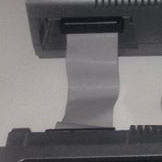
The original EI attached to the Model I CPU though a straight ribbon cable. This worked, mostly, except for 2 problems: The memory timings and the stiffness of the cable due to heavy shielding. If you used a TRS-80 desk, the expansion interface and Model I were in a secure position, so the hard cable wasn’t a problem; but if you didn’t have one, movement at any level could cause a loss of contact resulting in resets or freezes.
Expansion Interface Connection Rev 2:

To deal with this, Tandy tried to buffer all the signals. They modified the CPU to send the signals on a more direct route though terminated twister wire pairs to the connector on the CPU. The also picked up the signals in the EI at the connector and again use twisted wire pairs with termination right to where the signals were used in the EI. And the heavy stiff cable between the CPU and EI was replaced with a softer more flexible cable with an active ‘buffer block’ in the middle. This was the first of the ‘buffered ei’ mods. This helped, but only so much.
Actually, there were two versions of the buffered EI cable. If a customer had a ‘bus master’ device that took control and did DMA, the device couldn’t ‘back channel’ through the buffered EI cable. So upon request Tandy provided a Buffered EI cable with a pre-buffer ‘tab’. Instead of connecting your device to the expansion port on the side of the EI, you connected it to the tab on the special buffered EI cable. These were available free upon request. The only device Tandy sold that needed this device was the Screen Printer (nick-named the ‘Scream Printer’ by techs).
Expansion interfaces with the buffered cable but without the Rev 3 modification are fairly rare; they lasted only a short time before Radio Shack moved to Rev 3.
Ian Mavric currently sells an updated buffered cable for those who might need one called NewBuff.
Expansion Interface Connection Rev 3:
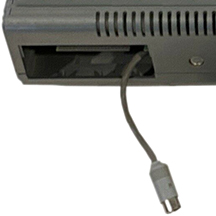
Click to Enlarge
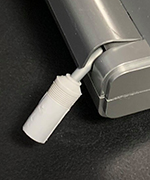
Click to Enlarge
The second generation of the buffered fix was to get the 3 problem signals off the cable altogether. So they came up with the fix. In that case they modified the CPU to have a 6-pin DIN cable with 3 twisted wire pairs on it. In the EI they added a matching 6-pin DIN receptical cable. This turned out to be very effective. But still not 100%. However by picking RAM the machines could be made very robust. (the RAM issue wasn’t fully identified until the Model III, But only a few machines had to cherry pick the RAM).
Expansion Interface Connection Rev 4 (Expansion Interface v2):
Tandy eventually redesigned the EI so that it did NOT use the RAS*, MUX, and CAS* signals. It did this by generating them on the EI pcb itself with a DDU chip. (a digital delay line) This was VERY effective and negated the need for a buffered EI cable so Tandy went back to the sheilded stiff cable.
Unfortunately, expansion Interfaces which generated their own signals were, unfortunately, not comaptible with “as is” speedup kits.
But, EIs were out there in both versions, so the factory production of CPUs contained the DIN cable since you didn’t know in advance which version of the EI it would be attached to.
Parts:
Computer



It isn’t clear how many of these units were ever sold. They were basically 16K chips that were tested or ‘high’ or ‘low’ half (i.e., defective). It is rumored that Radio Shack gave anyone who got one a free upgrade to 16K. Mike Yetsko says he definitely had upgrade instructions for when they came in. It is also believed that the catalog number for the “system” (with Monitor and Cassette) was 26-1052.



It isn’t clear that any of these units were ever sold. Tandy figured out they were not the greatest when dealing with the Level I, and may never have built any Level II’s this way. It is also believed that the catalog number for the “system” (with Monitor and Cassette) was 26-1054.

This Model I Level II was produced by Tokyo Electric Co. The board layout is different. More information on this can be found on page 71 of This TRS8Bit Newsletter.

-PO.png)
Click to Enlarge
Consists of:
- 16K Level II Complete System
- Printer Interface Cable
- Quick Printer
- Space-Saver Desk
For more technical applications, the “Engineer” system combines powerful level II with 16K of RAM. The new Printer Interface cable allows direct connection of the Quick Printer to TRS-80’s bus connection, without using the Expansion Interface. Quick Printer provides 80-column hard copy and program listings. The Space-Save holds the entire system and provides the user with ample work space.
-PO.png)
Click to Enlarge
Consists of:
- 16K Level II Complete System
- Expansion Interface
- Mini-Disk System
- Quick Printer Cable
- System Desk
Mini-disk for expanded language, fast data handling, and approximately 49,900 bytes of user disk storage space. Quick Printer provides 80-column hard copy and prorgam listings. System Desk holds the entire system with plenty of work space left over.
-PO.png)
Click to Enlarge
Consists of:
- 16K Level II Complete System
- Expansion Interface 16K RAM
- 2 Mini-Disk Systems
- Line Printer II and Cable
Two mini-disk units give user approximately 135,600 bytes of disk storage. Virtually all TRS-80 disk-based business software requires this as a minimum system. Applications include general ledger, payroll, disk mail list, and more. Line Printer II adds real versatility and convenience to this system, without taking up a lot of work space.
-PO.png)
Click to Enlarge
Consists of:
- 16K Level II Complete System
- Expansion Interface 16K RAM
- 2 Mini-Disk Systems
- Tractor Feed Line Printer and Cable
- System Desk
- Line Printer Stand
Approximately 135,600 bytes of disk storage space from the two mini-disk systems. Tractor feed line printer uses fanfold paper with feed holes in the margins and will produce up to 5 carbon copies. The System Desk has recessed spaces for the Expansion Interface and keybaord with interconnecting wiring concealed. Line printer stand leaves more desk space.
Optional Hardware – Expansion


Increases TRS-80’s Internal Memory. The TRS-80 is designed for easy upgrading to a full 16K of RAM memory inside the keyboard unit. Your nearest Radio Shack store can arrange for the exchange of your 4K for 16K chips and add the keypad.

This mythical item was to upgrade a 8K TRS-80 to 16K. It was up to the tech to install it as either high or low. It could not be expanded to more memory.

![[Numeric Keypad]](/images/hardware/hwimage-model1-numerickey.png)
Click to Enlarge
Makes entering data a lot faster when you’re used to using a standard calculator. Enter by either the keypad or typewriter keyboard numerals.
![[Lowercase Kit]](/images/hardware/hwimage-lower-case-kit-rsc05-[26-1104]-(rs).jpg)
Click to Enlarge
Bring your keyboard unit and we’ll do all the rest! Parts prices only. Required installation is extra.
Quality lower case for your Model I display and compatible printer. “Driver” tape included. NOTE: Some non-Radio Shack software will not work with this kit installed. Not intended for use with programs written in upper case format.

When you’ve mastered the Level I programming language, you can move up to higher computing power with Level II. Conversion is easy – we simply exchange the ROM chips in your TRS-80 for chips containing Level II. Your local Radio Shack store can arrange for the exchange. Incorporate Level II into your 4K or 16K RAM Level I TRS-80.
.jpg)
Click to Enlarge
Expansion is a key word in the TRS-80 philosophy. The TRS-80’s modular design lets you expand to just the system you want. Of course, you can add 16K RAM and Level II BASIC to the keyboard unit. Beyond that point, the Expansion Interface becomes the hub of expanded TRS-80 computer systems.
The Expansion Interface measures 4 1/2 x 16 1/2 x 8″ and is designed to sit directly under the video monitor acting as a base for it. The TRS-80’s power supply module, and an identical one for the interface, are housed inside the interface enclosure. Space is also provided for our optional RS-232-C Serial Interface Board.
A cable approximately 6″ long connects the interface to the TRS-80 bus connector. The interface provides output connectors for our TRS-80 printers, disk drives, dual cassette recorders, and an RS-232-C serial port, as well as an extension of the TRS-80 bus, the controller for the electronic circuit needed to install up to four TRS-80 Mini Disk drives, a printer and dual cassette recorders are an integral part of the Expansion Interface, as are the provisions for an extra 16K or 32K of optional RAM. The printer output port is a standard Centronics parallel circuit. This parallel port and our RS-232-C serial port allow connection of a variety of peripheral devices. Pin-out information is provided in the owner’s manual. Each requires 120VAC, 60Hz, 50 watts. U.L. listed.
![[Double Density Controller]](/images/hardware/hwimage-model1-doubledensity.jpg)
Click to Enlarge
Expand the disk capacity of your Model I and add the advanced features of Model III’s TRSDOS operating System. After Radio Shack has installed the kit in your Expansion Interface, your existing Model I software may still be used “as is” in single density mode.
With the all new Double-Density Disk Operating System, use advanced features and gain increased disk capacity with your current disk drives. With 35-track drives, disk capacity per diskette is increased from 84,000 to 152,000 characters after noemal normal system information. With a 40-track drive, formatted disk capacity is a full 184.000 characters, 737,000 characters with four 40-track drives. COPY moves flles from single-density to double-density format or from double-denslty to single-density. In addition to expanding TRSDOS to include new features, we have added most of Model III’s Disk BASIC enhancements as well. This includes full suppord for variable logical record lengths, and a series of CMD functions that sort strings, cross-reference string variables, delete spaces, and much more. Since our Double-Density TRSDOS contains manu new features, modification of some existing software may be required for use with double density. Even though most BASIC programs and many machine-language programs will run “as is” in Double-Density TRSDOS, Radio Shack applications software is not available or supported for double density operation. Kit includes operating system manual, adapter, and Double-Density TRSDOS operating system diskette. Price does not include required installation.
Optional Hardware – Storage


![[CTR-80A Cassette]](/images/hardware/hwimage-storage-ctr80a.png)
Click to Enlarge
Ideal for loading and recording cassette programs and data. U.L. listed. AC operation or 4 “C” batteries (not included).
![[CCR-81 Cassette]](/images/hardware/hwimage-storage-ccr81x250.png)
Click to Enlarge
Ideal for loading and saving your ownprograms and data on cassette tapes or using our ready-to-run cassette software. Battery/Record LED indicator. 10-1/2 x 5-3/4 x 1-13/16″. Includes cable. U.L. listed AC operation or four “C” batteries (not included).
![[CCR-82 Cassette]](/images/hardware/hwimage-storage-ccr82x250.png)
Click to Enlarge
Our most compact, lowest-priced CCR! Features volume control with preset marker. You can also monitor sound while saving programs and data. Tape counter matches CCR-81 to permit interchange of tapes. 8-1/8 x 4-11/16 x 1-5/16″. Includes cable. Requires four “AA” batteries or AC adapter (not included).
![[Floppy Drive x 1]](/images/hardware/hwimage-model1-floppy1.png)
Click to Enlarge
The TRS-80 Mini-Disk system is a storage medium allowing immediate access to large amounts of data and programs you will need for accounting, inventory control, mailing lists and other jobs. Up to 4 drives can be attached through the expansion interface, furnishing 49,900 to about 307,000 bytes of on-line storage. The first Mini-Disk drive you purchase includes our powerful TRSDOS (Disk Operating System software) and Disk BASIC on diskette. This diskette allows about 50K of user storage space. TRSDOS and Disk BASIC use about 10K of the TRS-80’s RAM, so a minimum of 16K is required, along with Level II and an Expansion Interface.
Each of the diskette’s 35 tracks consists of ten 256-byte sectors. Certain system information and a directory are required on each diskette, leaving 85,760 bytes of space available (each) on the second, third, and fourth drive.
A 13,000-byte program which takes 3 1/2 minutes to load from cassette tape (Level II) will load in less than 20 seconds from disk. And you may read information one file after the other (sequential), or go directly to any sector without reading the preceding files (random).
The system diskette containing TRSDOS and DISK BASIC must always be in your first drive unit. TRSDOS allows you to copy a diskette (BACKUP), even in a one drive system.
Specifications: Disk Format: 35 Tracks; 10 Sectors per Track; 256 Bytes per Sector; 89,600 Bytes per Diskette. Disk Size: 5 1/4″ floppy disk. Data Transfer Rate: 12,500 bytes-per-second. Disk Speed: 300 RPM. Latency: 100 mS (average). Track Access Time: 200 mS average, 600 mS to cross all 35 tracks. Average Backup Time: 1:10 minutes (including formatting). Memory Usage: TRSDOS, 4.2K RAM; DISK BASIC, 5.8K RAM. Power: 120VAC, 60 Hz, 35 watts, U.L Listed. Size: 6 1/2 x 3 1/2 x 13 1/4″
![[Hard Drive]](/images/hardware/hwimage-harddrive.png)
Click to Enlarge
Our 5 megabyte Hard Disk System gives you vastly increased data storage with exceptionally fast access and ease of use. Winchester technology can provide dramatic improvements in speed. The advanced operating system’s many superior, user-friendly features make file handling a breeze.
Store over 1000 different files per disk system or create files as large as the available space. The directory is alphabetized to make locating and accessing files quick. High-level communication is available through an advanced communication package that allows direct downloading to disk. A print spooler is included, too. The Job Control Language allows you to compile and later execute a predefined series of commands, including screen and audio alerts, conditionals, and user interaction to make many large scale operations virtually automatic. BACKUP, in addition to ordinary backup functions, permits backing up only those files that have been modified, or modified in certain date ranges, or even those that do or do not already exist on the destination disk. When backing up from hard disk to diskettes, the system will span a large file across multiple diskettes and allow easy identification of diskettes when recreating a file on the hard disk. Other features include keyboard typeahead for fast data entry, a versatile printer output formatting program, key redefinition, and more. Extensive user’s manual included. U.L. listed.
Optional Hardware – Misc

![[Carrying Case]](/images/hardware/hwimage-model1-carryingcase.png)
Click to Enlarge
Take your TRS-80 system with you wherever you go! One case holds the video monitor, the other holds the keyboard unit, power supply. cassette recorder, cables and cassettes. Black molded vinyl. Hand carry only-not designed for shipping purposes.
![[Dust Cover]](/images/hardware/hwimage-system-dust-cover-rsc03-[26-0501]-(rs).png)
Click to Enlarge
Keep your system in top condition when it’s not in use. Custom vinyl covers fit snugly over systems, disk drives or line printers.
![[Dust Cover]](/images/hardware/hwimage-dust-cover-for-external-disk-drives-rsc08-[26-0502]-(rs).png)
Click to Enlarge
![[Dust Cover]](/images/hardware/hwimage-printer-dustcover.png)
Click to Enlarge
Protects printers against dirt and scrapes.
![[Dust Cover]](/images/hardware/hwimage-glarescreen.png)
Click to Enlarge
Reduce glare with no loss of resolution. Reduces eye strain and fatigue. Installs easily in seconds.
![[Voice Synthesizer]](/images/hardware/hwimage-voice-synthesizer-rsc03-[26-1180]-(rs).png)
Click to Enlarge
Now you can program your TRS-80 to speak. It’s not a pre-recorded human voice, but electronically ‘synthesized” speech projected through a built-in speaker. It plugs into your TRS-80’s bus connector on keyboard or Expansion Interface. Programming spoken words is done by typing combinations of some 60 “phonemes” representing spoken sounds. Requires Level I or II-16K RAM preferred.
![[VoxBox]](/images/hardware/hwimage-voxbox-rsc03-[26-1181]-(rs).png)
Click to Enlarge
Experiment with “voice recognition” on your TRS-80. That’s right, speak into a microphone attached to the VOXBOX and you can program your TRS-80 to respond to your spoken words.
Computer voice recognition is a new field, and not fully developed, but here’s your chance to experiment with this exciting new technology. Level II required.
![[Digitizer]](/images/hardware/hwimage-digitizer.png)
Click to Enlarge
Ideal for Engineering, Architectural Work, Drafting, Medical or other Chart Analyses, and much more.
Place this unique instrument on a map, chart, or plan of any size. Works with an 11×17″ area. Swivel head allows operation in vertical plane. Input coordinates quickly, easily to your computer. Measure areas, lengths, distances and more. Point and continuous modes. Includes software for basic applications. U.L. Listed.
![[Network 1 Controller]](/images/hardware/hwimage-model1-network1x200.png)
Click to Enlarge
A breakthrough in computerized classroom instruction! Network I allows teachers to upload and download programs to as many as 16 TRS-80 student stations. LED lamps indicate when a program transfer to or from a station is in progress.
The system requires a Model I “host” computer equipped with at least one Mini-Disk drive. Student stations should have Level II BASIC. Network I Controllers can be cascaded to connect more stations. Includes cables. Maximum distance to student station is 30 feet. For Model I and Model III TRS-80’s at 500 baud. U.L. Listed.
![[Network 2 Controller]](/images/hardware/hwimage-model1-network2.png)
Click to Enlarge
RSC-11
Network II allows teachers to upload and download programs to as many as 16 TRS-80 student stations. Requires a Model I or III “Host” computer with at lease one Mini Disk drive and up to 16 Model I or Model III student stations, or a Color Computer with disk for “host” and up to 16 Color Computers for student stations. Controllers can be cascaded to connect more stations. Includes cables.
RSC-12
Allows easy management of student programs. You can simultaneously load a program into all 16 student systems at either 500 or 1500 baud, depending on the TRS-80 computersused. With optional printer connected to host computer, student programs can be loaded into the host and printed out. Use with Model I/III/4 as host and student stations, or with Color Computers as host and student stations. The Network 2 can be used to transfer ASCII files with Model 100 student stations and either a Model 100 or a Model 4 host. Controllers can be cascaded to connect more stations.
![[Plug N Power]](/images/hardware/hwimage-plug-n-power-controller-ccf833-[26-1182]-(rs).png)
Click to Enlarge
Now your TRS-80 Model I, Model III or Color Computer can control up to 256 lights and appliances automatically! The Controller connects to the cassette port of your TRS-80 and sends the computer’s commands through the existing AC wiring to the plug-in Remote Modules (sold separately).
Has a built-in real time clock and a switch permits normal cassette operation. Software included. 4K Level I, Level II or Model III BASIC required. U.L. listed.
Optional Hardware – Modem/RS-232

![[DC-1200 Modem]](/images/hardware/hwimage-modem-dc1200x350.jpg)
Click to Enlarge
Ideal for anyone who regularly has big transmissions to handle. By quadrupling the baud rate, the DC-1200 will reduce each phone bill to a fourth of what it otherwise would have been. It’s ideal for people who use electronic information services during business hours when long distance rates are at their highest.
All you do is plug the power cord into a wall socket, the line cord into the phone jack and the connecting cable to our RS232C-equipped computer. It’s always in “Auto Answer,” so that if a host computer calls you (and your computer is properly configured), you can begin receiving information automatically. The modem automatically adjusts to the incoming baud rate. To originate, you just set the baud rate to match the host or service, run your communication software package, and place the call. And you can upgrade your DC-1200 for automatic origination.
Specifications: Data Rate: 0-300-baud asynchronous; 1200-baud asynchronous or synchronos. Operating Mode: Full or half-duplex, all speeds; automatic answer, manual originate. Line Signals: Low Speed – frequency shift keying; High Speed – differential phase-shift keying. Compatibility: Low Speed – Bell 103/113; High Speed – Bell 212A. Sensitivity: -45 dBm. Dimensions: 1-3/4 x 6-3/8 x 11-1/4″. Power: U.L. listed 120VAC, 60 Hz power module. FCC registered. Note: DC-1200 not for multi-line use without optional extra controller. Use only with Bell-compatible equipment.

To make your DC-1200 high-speed modem even more useful and versatile, add this handy accessory module. It allows the DC-1200 to automatically dial, as well as answer the phone (with proper computer configuration). This means your computer can operate unattended during low-rate night hours. Plug-in module is a printed circuit board. Installation required (not included).
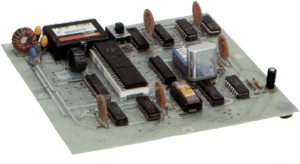
Click to Enlarge
You can let your TRS-80 communicate with the “outside world” by using our TRS-80 RS-232C Serial Interface Board. It lets you connect the TRS-80 to a variety of accessories such as modems, card reader, line printers and acoustic couplers.
The RS-232-C board mounts inside our Expanasion Interface. A cable is provided for connection to external equipment such as Radio Shack’s Telephone Interface or perhaps your own serial line printer. Included is a comprehensive user’s manual and a cassette tape program which allows the TRS-80 to act as an interactive terminal for communication with a remote timesharing computer.
Baud Rate: Switch selectible in 8 steps from 110 to 9600 baud. Software contrallable in 16 steps from 50 to 19,200 baud. Stop Bits: Selectable 1 or 2. Word Length: Selectable 5 to 8 bits. Data In/Data Out Ports: Switch reversible. Logic State Sensing: Clear to end, Data set ready, Carrier Detect, Ring Indicator. Software Controllable Outputs: Data Terminal Ready, Request To Send. Software control: All functions except Data In/Data Out reversing are fully software controllable.
![[Telephone Interface 1]](/images/hardware/hwimage-telephone-interface-ii-rsc03-[26-1171]-(rs).png)
Click to Enlarge
Radio Shack’s Telephone Interface I lets the TRS-80 “talk” with other computer equipment over the phone! After the proper number has been reached. you simply place your telephone handset in the Interface’s cradle – without a single electrical connection to your telephone lines.
This Radio Shack coupler converts a serial stream of data from the TRS-80 RS-232-C interface into selective audio tones which are then transmitted over standard telephone lines. It can also reverse the process, decoding selective audio tones and feeding them into the TRS-80 throughthe RS-232-C interface. (The RS-232-C allows the TRS-80 to communicate with the outside world via a 2-wire connection, but with electrical signals. Since electrical signals cannot be sent over a voice telephone line, the Telephone Interface converts those signals to audio tones so that the connection can be made over long distances via telephone.) The TRS-80 Telephone Interface I operates in the “originate only” mode, meaning that it can send information to other hardware. It is capable of “two-way communication” only with another computer system having ‘originate and answer” capabilities.
Specifications: Baud Rate: 300 baud. Mode: Originate only, half or full duplex. Carrier Detection Level: -40 dbm. Transmit Level: -17 dbm at 1070 Hz. Power Requirement: 120VAC, 60 Hz, 5 Watts. U.L. listed.
.png)
Click to Enlarge
This is the fast way to transfer data from one location to another – by telephone with the Telephone Interface II. It’s a full “originate/answer” acoustic coupler which allows two TRS-80’s to talk to each other. You can also communicate with another computer which has “originate only” capability (like our Telephone Interface I). You can pass all types of data or prograas between computers, or one of you can operate the other’s computer via the telephone lines. No direct connection to the telephone line is required.
It’s very simple to operate. Just dial the phone number at the location of the TRS-80 you desire to communicate with; after the connection is made, each telephone handset is placed on its interface. Now you’re ready to receive and transmit data. Requires RS-232 Serial Interface Card, Expansion Interface, RS-232 Conununications Package and Level II. Adds versatility to your TRS-80.
Specifications: Baud Rate: Up to 300. Mode: Originate and Answer, full or half duplex. Receive Sensitivity: -45 dBm. Power Requirement: U.L. listed 120-volt AC power module. Size: 2-3/8 x 4-3/4 x 10-1/4″.
![[Modem 1]](/images/hardware/hwimage-modem1.png)
Click to Enlarge
Connects directly to the telephone line and your computer, eliminating data loss due to microphonic interference. Provides full-duplex operation for TRS-80 Model II, Color Computer, as well as Model I and Model III systems equipped with RS-232 interface. Also provides half-duplex operation for Mode1 I systems without Expansion Interface or RS-232. Features selecable 300/600-baud operation, LED indicators, U.L. listed AC power module. FCC approved.
Specifications: Baud Rate: 300. Modes: Compatible Bell 103 Ans/Orig modes. Full duplex. Sensitivity: -43 dBm (orig), -48 dBm (ans). Connectors: DB25 and 4-pin DIN. Power Requirement: U.L. listed 120-volt AC power module. Size: 2 x 6-1/2 x 7-1/2″. Not for multi-line use.
![[Modem 2]](/images/hardware/hwimage-modem-modem2.png)
Click to Enlarge
A fully-programmable direct-connect modem with Auto-Dial and Auto-Answer capability. Automatically dials or answers the phone, receives and transmits data, and even hangs up the phone. Remote and local test modes. LED indicators for On, Off-Hook, Terminal Ready, Carrier Detect, Transmit Data, and Receive Data. FCC Approved.
Specifications: Baud Rate: 300. Mode: Originate and answer, full or half duplex. Receive Sensitivity: 45 dBm. Dial System: Rotary or tone. Power Requirement: U.L. listed 120-volt AC power module. Size: 2 x 6-1/2 x 7-1/2″. Not for multi-line use.
![[Acoustic Coupler AC-3]](/images/hardware/hwimage-modem-acoustic3x350.png)
Click to Enlarge
Ideal for travelers! Just dial the desired number and place handset on interface. Half duplex also. Sensitivity: -43 sBm. 2-3/8 x 4-3/4 x 10-1/4″.
![[DCM-6]](/images/hardware/hwimage-modem-dcm6(1393).jpg)
Click to Enlarge
Plugs directly into module phone jack. Uses standard DB25 serial connector plus 8-pin DIN (for optional extra Acoustic Coupler 2). Features full-duplex operation, originate/answer modes, and 300-bps transmission. Includes a modular phone cable. Bell 103 compatible. FCC registered. U.L. Listed.
![[DCM-7]](/images/hardware/hwimage-modem-dcm7(1394).jpg)
Click to Enlarge
Switch selectable between Hayes and Tandy command sets. Easy-to-use auto-dial/auto-answer and full-duplex operation. Connects directly to modular phone jack. Bell 103 compatible. FCC registered. U.L. Listed.
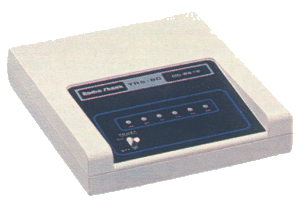
Click to Enlarge
High-speed transmission cuts long-distance costs to save you money! Automatically dials and answers phone, receives and transmits data, hangs up phone. Easy-to-use, menu-driven, Direct-connect, Bell 212A-compatible asynchronous or synchronous operation. Compatible with any RS-232C equipped computer. FCC registered. U.L. listed.

Allows direct-connect modems to be used with multi-line phones.
Optional Hardware – Furniture (Non-Printer)

.jpg)
Click to Enlarge
Attractive and functional. Keyboard and Expansion Interface fit into desktop, with interconnecting wiring concealed. A bay under the desk can house from one to four Mini Disk Drive units. Add a Quick Printer and here’s plenty of workspace left. 27 x 48 x 27″.
.jpg)
Click to Enlarge
It’s only 37 3/4 x 23 3/4″ but it holds a TRS-80, cassette recorder, CRT, Expansion Interface, Quick Printer and single or dual disk drives. Space saver was designed to hold your TRS-80 system and still leave ample room for work. The low-cost answer for home or educational users.
![[Deluxe Terminal Stand]](/images/hardware/hwimage-stand-264306x300.png)
Click to Enlarge
Perfect for the Model II, 12 or 16 computer. Rolls to where it’s needed. Features locking casters. Large 30 x 30″ top is adjustable at 26″, 27″ or 28″ heights. Easy to assemble.
![[Deluxe Workstastion]](/images/hardware/hwimage-stand-264303x300.png)
Click to Enlarge
Plenty of convenient working space, with wiring cutouts in top. Heavy-duty constructions. Easy to assemble. 27 x 48 x 30″
![[Desk Drawer]](/images/hardware/hwimage-26-4304-furniture-desk-drawer-rsc-09.jpg)
Click to Enlarge
Mounts on left or right. 12-3/4 x 18-1/2 x 20-1/4″
![[Modular System]](/images/hardware/hwimage-stand-modularsystemx300.png)
Click to Enlarge
Attractive and functional design in beautiful simulated oak finish. Each furniture piece make a handsome addition to home or office. Twin cable management slots for easy connections. Adjustable glides. 27 x 49-3/4 x 29-3/8″.
![[Modular System]](/images/hardware/hwimage-stand-modularsystemx300.png)
Click to Enlarge
Mounts on System Desk. Ideal for software binders and accessories. Assembles with adjustable “second shelf” on either side.
![[Modular System]](/images/hardware/hwimage-stand-modularsystemx300.png)
Click to Enlarge
The finishing touch – puts it all together! Connects system desk and printer stand for a convenient “work corner.” Mounts on right or left side of desk. Adds approximately 4 square feet of working surface.
![[Modular System]](/images/hardware/hwimage-stand-modularsystemx300.png)
Click to Enlarge
Large enough to accomodate wide-bed printers. Includes bottom-feed paper slot, unique swing-down paper catch for printed output and paper storage shelf. Adjustable glides. 27 x 28-1/2 x 19-1/2″
![[Computer Table]](/images/hardware/hwimage-space-saving-computer-table-rsc09-[26-1324]-(rs).png)
Click to Enlarge
Small enough to let you set up your system nearly anywhere. Large enough for the TRS-80 Color Computer or even the Model 4 or III. Easy to assemble. 27 x 48 x 24″
![[Printer and Monitor Platform]](/images/hardware/hwimage-stand-261360x300.png)
Click to Enlarge
Accomodates standard computer monitor or narrow-bed printer (DMP-105, 110, 120 or 200, Line Printer VII or VIII). Top measures 16-3/4 x 13-3/4″ with 5″ clearance for printer paper. Printer shown but not included.
![[Budget Computer Stand]](/images/hardware/hwimage-stand-261354x300.png)
Click to Enlarge
Our lowest-priced computer desk. Ideal for any home computer system. Includes raised platform for your monitor or printer, plus a storage shelf for disk drives, software, and accessories. Easy to assemble. 26 x 32 x 19-3/4″
![[Budget Printer Stand]](/images/hardware/hwimage-stand-261355x300.png)
Click to Enlarge
Matches either Computer Stand or Computer Table. Large enough to accomodate wide-bed printers. Includes bottom-feed paper slot and paper storage shelf. Easy to assemble. Adjustable glides. 26 x 26-7/8 x 19-3/4.”
![[Anti-Glare Panel]](/images/hardware/hwimage-anti-glare-panel-rsc08-[26-1457]-(rs).png)
Click to Enlarge
Our best! Special optically-coated panel cuts screen glare by 94%. Maximizes contrast and readability. Self-adhesive mounting.
![[Anti-Glare Mask]](/images/hardware/hwimage-anti-glare-mask-rsc08-[26-0511]-(rs).png)
Click to Enlarge
Nylon mesh screen reduces surface reflections, cuts overhead glare and improces contrast without loss of monitor resolution. Installs in seconds on Model I/II/III/4/12/16 computers.
![[Disk Head Cleaner]](/images/hardware/hwimage-storage-diskcleaner.png)
Click to Enlarge
Cleans drive heads safely and easily. Just apply special solution to cleaning diskette and run in drive for 30 seconds. With cleaning diskette, solution and instructions.
![[Typing Easel]](/images/hardware/hwimage-misc-typingeasel.png)
Click to Enlarge
Adjustable T-bar (8-3/4″ to 13-7/8″) and friction pads keep books or manuals open and in place. Cushioned base prevents slippage and protects furniture. Folding legs for compact storage.
Computer Reference Books


How to use print codes and other special features. Explains dot-addressable graphics. Includes BASIC programming examples.

-PO.png)
Click to Enlarge
(Tandy).jpg)
Click to Enlarge
Entertaining introduction to Level II and Model III BASIC programming. Excellent for beginners. Sample programs and exercises. 342 pages.
(Radio-Shack).jpg)
Click to Enlarge
Includes over 5300 ready-to-run programs of all types for sale by a variety of vendors.

The first 20 issues in one volume.
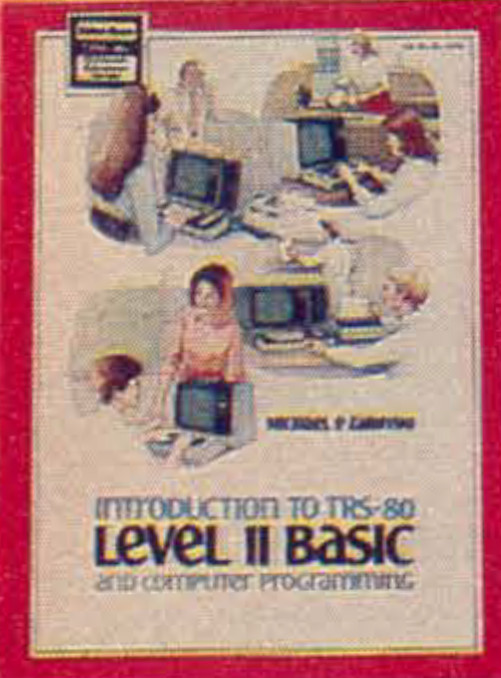
Click to Enlarge
Features sequential introduction of new concepts, with exercises at the end of each chapter

January thru December, 1981 bound in one volume.

January thru December, 1982 bound in one volume.
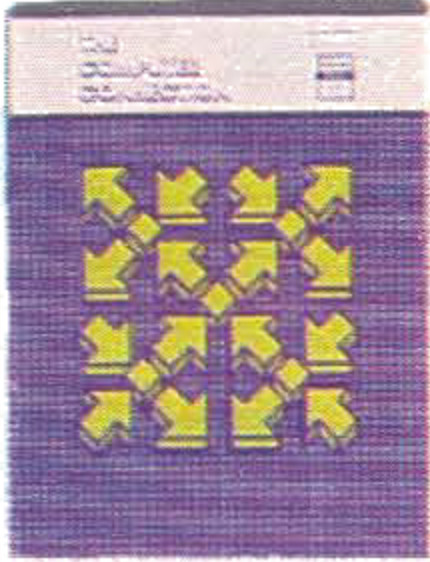
Click to Enlarge
Click to Enlarge
Introduces the basics of computer literacy to junior and senior high school students using easy-to-understand approach. Includes teacher’s guide with lesson plans, student activity spirit masters, four wall charts and 80-frame filmstrip with audio cassette. Computer not required.
(Radio-Shack).jpg)
Click to Enlarge
Vendor furnished listings include descriptions of programs and important characteristics. Many include user-site references. New listings for all TRS-80 computers.
(Bob-Albrecht).jpg)
Click to Enlarge
Teacher’s guide to helping elementary students understand and enjoy the BASIC computer programming language.

This 36-page booklet shows how to introduce sequences and series in an entertaining way using computers.

For educators seeking funding from an outside source, such as the Federal governement or a private foundation. Emphasizes computer-related education projects.
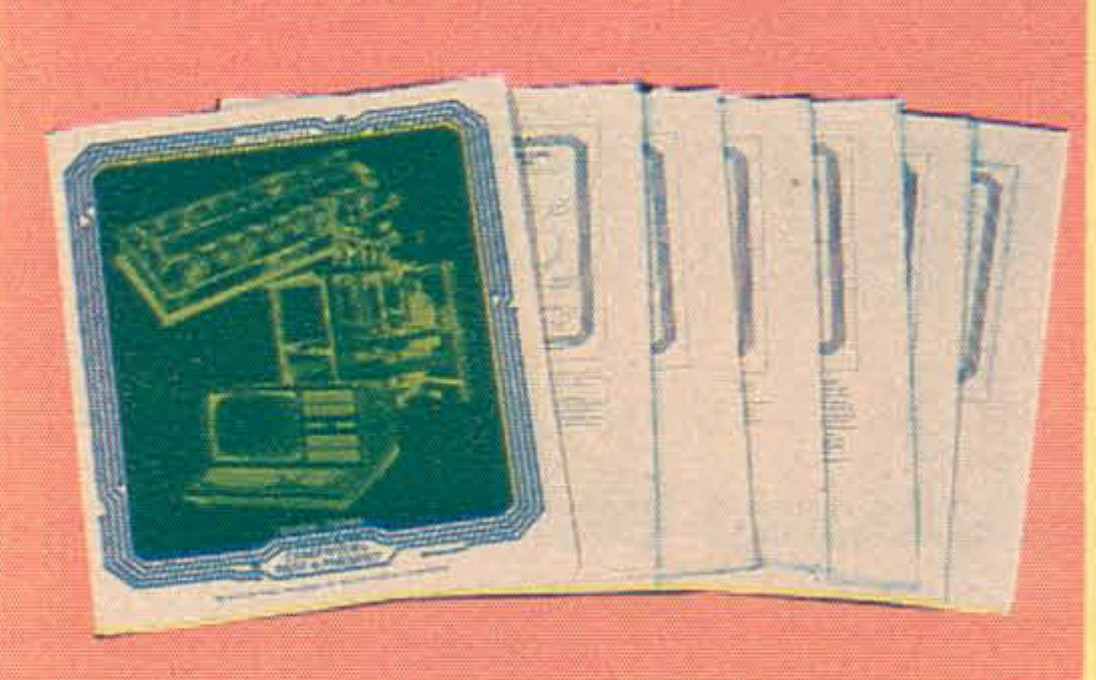
Click to Enlarge
Click to Enlarge
Illustrates the history of computers for students in grades 4 through 8. Explains what a computer is, what it can do, and how it works. Includes teacher’s guide, six spirit masters and a colorful 22″ x 34″ wall chart.

This informative booklet describes what microcomputers are and how they can be used in classrooms and for administrative purposes. Discusses costs, courseware and other related subjects that are of special concern to the educator.

Informative package to help secondary students explore computer-related careers. Covers major computer career areas and specific jobs within selected areas. Includes teacher’s guide, 30 student manuals, narrated film strip, eight spirit masters, and colorful wall chart.


A comprehensive, illustrated “owner’s manual” for Model II users. (Included with all Model II systems.)

Includes theory of operation for the CPU Module, FDC, video/keyboard, video display, disk drives, and the power supplies.
(Tandy).jpg)
Click to Enlarge
A complete listing of agricultural programs. Covers specific applications and user levels.
(Management-Information-Source).jpg)
Click to Enlarge
Learn how to utilize this versatile forecasting tool. 184 pages.
(Management-Information-Source).jpg)
Click to Enlarge
Get the most out of this “second generation” spreadsheet analysis program. 184 pages.

Covers history, hardware, programming and languages of computers. Includes operating system programs. 256 pages.

Clear, understandable definitions. many with illustrations. Reference section of abbreviations. acronyms and symbols. 96 pages.
(Radio-Shack).jpg)
Click to Enlarge
Covers microcomputers, hardware and software. 304 pages.
(Radio-Shack).jpg)
Click to Enlarge
Explains digital electronic devices, circuits and systems. 240 pages.
(Houghton-Miflin).jpg)
Click to Enlarge
Easy-to-understand introduction to writing programs. 156 pages.
(Radio-Shack).jpg)
Click to Enlarge
Self-paced programmed instruction for Level II BASIC. Quickly gets you into programming. Sample programs. 232 pages.
(Texas-Instruments).png)
Click to Enlarge
Learn what microprocessors are and how they can be used. 296 pages.

Description of the basic means of electronic communications. 256 pages.
(Radio-Shack).jpg)
Click to Enlarge
Easy-to-read programmed course on digital computer basics. 160 pages.

Self-study Level I BASIC for the TRS-80 Model I and III. Informative self-instruction course with lots of examples. 351 pages.
(William-Barden).jpg)
Click to Enlarge
An excellent supplement to Level II BASIC. 142 pages.
(Radio-Shack).jpg)
Click to Enlarge
Shows how to create graphic displays – from line drawings to geometrics to simple moving-figure animation. 142 pages.
(Tom-Rugg).jpg)
Click to Enlarge
32 fully documented, ready-to-run programs. 267 pages.
(Sybex).jpg)
Click to Enlarge
Educational text and self-contained reference. From basic concepts to advanced data structures manipulations, with comprehensive description of all Z-80 instructions. 626 pages.
(Radio-Shack).jpg)
Click to Enlarge
Packed with applications for the TRS-80 Level II plus ideas for creating your own programs. 343 pages.

Exciting and challenging games for the Level 11 TRS-80. 152 pages.

Includes finance, automobile-related, kitchen helpmates, tutorial, recreation, more. 330 pages.
(Don-Inman).jpg)
Click to Enlarge
Helps you fully realize the capabilities of the TRS-80 Model I and III. Sample programs and chapter summaries. 250 pages.
(Don-Inman).jpg)
Click to Enlarge
Discusses line drawing, special graphics characters, pixel graphics, simple animation. 134 pages.
(William-Barden-Jr).jpg)
Click to Enlarge
Techniques and projects. Z-80 instruction set and codes. 430 pages.
(Barden-Radio-Shack).jpg)
Click to Enlarge
Comprehensive guide to all TRS-80s. 228 pages.
Software (Ordered by Catalog Number)

(Tandy)[26-1568].jpg)
Click to Enlarge
Ideal for the doctor’s office or small clinic. Prints monthly statements, insurance forms, daily recap, transaction review, aged accounts receivable, and more. Up to 3960 patient accounts with a Model I system or 4200 with a Model III. Up to 200 different procedures and diagnoses. (48K 4-Disk).
(Tandy).jpg)
Click to Enlarge
Radio Shack’s COBOL (Common Business Oriented Language) is based on the ANSI ’74 COBOL standard, and provides a single-step compiler for fast execution, multikey ISAM for quick data access, COBOL editor for creating and changing source programs, and a DEBUG for program development and testing. lncludes System User’s Guide, COBOL Editor Guide, and an extensive COBOL Reference Manual. (48K 2-Disk)
(Tandy).jpg)
Click to Enlarge
Lets you program in familiar BASIC, and gain powerful business extensions. Advanced features include single-key ISAM to help organize and retrieve data, cross-reference and interactive DEBUG to speed program development, easy calls to assembly language or other object programs, and 14-digit floatin point decimal formats. (NOTE: Compiler BASIC is intended for program development and not for conversion of existing software. It’s not compatible with Level II or Model III BASIC programs.) Includes Compiler and Run-Time Diskettes, plus detailed 420-page reference manual. (48K 2-Disk).
(Microsoft-Radio-Shack)[a].jpg)
Click to Enlarge
Includes compiler, editor, linking loader, library. (32K 2-Disk-Model I only).
(Tandy).jpg)
Click to Enlarge
Access names, addresses, accounts, personnel records, and more- in just seconds! Powerful editing features make changes easy. Files can interact with simple BASIC programs. Printer optional. (32K 1-Disk)

Finds facts on file that match “key-words” in your question. A “global search” even finds the “most similar” information when there’s not an exact match. (32K 1 -Disk).
(Tandy).jpg)
Click to Enlarge
Designed for maximum flexibility and speed. Information can be stored, sorted, retrieved, displayed, and printed quickly with simple sentences and single-key instructions. Printer optional. (32K 1-Disk).
(Software-Arts).jpg)
Click to Enlarge
This program alone will justify your owning a TRS-80! It’s a versatie management and engineering planning and forecasting tool that replaces pencil, calculator, and columnar pad. It lets you create an “electronic worksheet.” Each time you change a variable, VisiCalc updates every related number in seconds! For example, suppose you’re considering leasing or purchasing new equipment. Simply enter the new costs and savings into a VisiCalc spread sheet containing current and projected profit and loss figures. VisiCalc will instantly recalculate every related figure to show the possible effects, and help you decide whether to lease or buy. Instant “what if … ” projections are a real aid for the decision maker. VisiCalc provides numeric accuracy of up to 11 digits, scientific notation, and functions like SIN, COS, TAN, LOG and more-so it’s ideal for solving complex en ineering problems. Produce bar graphs, access Visi 8 alc data files from BASIC, and print any portion of your worksheet with an optional extra printer. (32K l-Disk- Model I only).
(Tandy).jpg)
Click to Enlarge
A new and expanded version of SCRIPSIT! Features true proportional-spaced printing, multiple line spacing within a document, underlining, double underline, boldface, super and subscript, pause during printing to permit additions from keyboard, and more. User-defined keys can recall up to 127 predefined keystrokes. Comes with training manual, audio cassette course, and reference card. Use with our Profile III Plus program to S enerate form-type letters. (48K, l-Disk).
(Tandy).jpg)
Click to Enlarge
Automatic “proofreading” for documents prepared with SCRIPSIT, Super SCRIPSIT, and even ASCII files! Displays and corrects errors. Contains over 60,000 commonly used words (30,000 with a Model I system). Add words of your own, too. (48K 2-Disk).
(Tandy).jpg)
Click to Enlarge
Send messages from your TRS-80 directly to a Post Office near your addresses via Western Union Electronic Mail Inc. for delivery in the next business day’s mail. (RS-232, Coupler, and 16K Level II or Model III BASIC req’d)

Convert field measurements into final dimensions and coordinates (16K Level II or Model III BASIC req’d)

Provides trend change indications for shot, medium and long term periods based on formulas used by professionals. Maintains portfolio for stocks of your choice. Provides trend recognition aid, not investment counsel.
(Tandy).jpg)
Click to Enlarge
Challenging jungle adventure.
-PO.png)
Click to Enlarge
Personal horoscopes. Produces chart with optional printer.
(Eric-Quintana-Tandy).jpg)
Click to Enlarge
Combines paddle field with fast paddle action.
(Tandy).jpg)
Click to Enlarge
The “Demon” tap dances to “Ain’t She Swwet” with computer acompaniment – or create your own music and dance routine!
(Tandy).jpg)
Click to Enlarge
Solve the mysteries and get out alive.
(Radio-Shack).jpg)
Click to Enlarge
Software package used with Telephone Interface II allowing the TRS-80 to communicate with anotehr TRS-80 as a host terminal combination. Also lets you transfer programs between TRS-80s. Contains 5 cassettes. 16K Level II required.
3 programs: “COMPAC” transmits a program or data. “HOST” allows TRS-80 control from a remote terminal. “TERM” makes TRS-80 a dumb terminal.
(Tandy).jpg)
Click to Enlarge
Calculates paychecks, including tax and other deductions. Stores year-to-date and quarter-to-date info for 11 employees.
(Tandy).jpg)
Click to Enlarge
Computerized card filing system.
(Tandy).jpg)
Click to Enlarge
Keep an updated file of names and print labels (with optional printer). 80 names per data file with 16K. 250 names with 32K.

16K cassette holds 15 employees, 32K holds 75 and 32K Disk holds 40. Prints checks and register. Supports fixed-percentage state and city tax.
(Tandy).jpg)
Click to Enlarge
Compose and edit text on the video display, then use an optional printer to produce correction-free letters and reports. Features centering. headers, footers, global search and more. Save text on cassenbs tor later revision.
(Tandy).jpg)
Click to Enlarge
3 programs: “Buy and Sell” for stocks, funds and bonds. “Summary” computes long and short term capital gains. “Options” tracks up to 10 positions, computes returns and unrealized gains.

A complete stock analysis and portfolio management package
(Tandy)[26-1513].jpg)
Click to Enlarge
An electronic spreadsheet for forecasting and problem solving. Enter labels and numbers in row/column format. Change a value or formula and all affected figures are updated automatically.

Selective printing from one of seven key fields. Approx. 600 names per data diskette, or 200 names on system diskette. 16K Disk.
(Radio-Shack).jpg)
Click to Enlarge
240 entries per session and 1830 per month with up to 100 accounts
(Tandy)[26-1553].jpg)
Click to Enlarge
Retail inventory record keeping and control – up to 1000 items. Tracks vendors, backorders, order dates, out of stock and on-order items. 32K Disk.
(Tandy).jpg)
Click to Enlarge
75 vendors, 100 transactions, or 200 vendors 800 transactions per month. Prints checks, register cash flow analysis and summary of activity for posting General Ledger. 32K Disk
(Tandy)[26-1555].jpg)
Click to Enlarge
300 customers 1000 transactions per month or 100 customers 2000 transactions per month. Prints aged reports, monthly statements, and summary. For posting general ledger. 32K Disk
(Tandy).jpg)
Click to Enlarge
1000 employees and 14 user-defined earnings and deductions categories. Prints payroll checks and W-2 forms for any state.

Foundation and structural cost estimating for contractors. Calculates material requirements, labor component, productivity and waste.
(Radio-Shack).jpg)
Click to Enlarge
Fast sort in Zip Code or any other sequence. 32K “Business System” – 990 names, 4 disk (48K) – 2970 names.
(Tandy).jpg)
Click to Enlarge
Raw materials inventory for 1900 items. Up to 20 finished goods per diskette. Prints bill of materials, material requirements and more.

Control over fixed asset depreciation. 32K Disk.

Attorneys, CPAs and Job Contractors. 750 clients 1250 charges per month. Up to 26 user-defined charge codes, up to 5 partners with different rates.

Enter and edit text on video screen, save text on disk, output formatted copy to printer. Buffered input for high speed typing without dropouts. Stop tabs, horizontal and vertical centering, formatted headers and footers, automatic page numbering, block manipulation and more.
(Radio-Shack).jpg)
Click to Enlarge
Stepped income analysis, compound interest, internal rate of return, resale price.
(Radio-Shack).jpg)
Click to Enlarge
Mortgage analysis.
(Tandy).jpg)
Click to Enlarge
Detailed property income calculations, appreciation/depreciation estimates.

Ellwood analysis, overall capitalization rate, graphic analysis, sensitivity analysis.

Programs for cash flow and depreciation.

Building development, Monte Carlo time trend, decision tree analysis.
(Tandy).jpg)
Click to Enlarge
Balance checkbook, maintain monthly budget.
(Tandy)[26-1603].jpg)
Click to Enlarge
Up to 60 budgeted accounts with 25 cash expenses. 20 savings transactions. 50 checks per month. Prints various reports.
-PO.png)
Click to Enlarge
Teaches fundamentals of arithmetic
(Tandy)[26-1702].jpg)
Click to Enlarge
6 self-paced lessons on 3 tapes.
(Radio-Shack)[26-1703].jpg)
Click to Enlarge
Random sample, histogram, descriptive statistics, T-test, simple correlation, linear regression.

Obtain 15 digit accuracy with sine, cosine, arctangent, natural logarithm, exponential and square root functions.
(Tandy)[27-1705].jpg)
Click to Enlarge
Advanced versions of 26-1703 programs plus frequency distribution. Multiple linear regression, time series analysis.

Analyze data and forecast trends. Includes random sample, histogram, frequency distribution, regression and much more.
(Tandy).jpg)
Click to Enlarge
8 tapes with 38 programs on vocabulary, antonyms, synonyms, analogies, number series.

Includes: Student Guide, Teacher Guide, Algebra I, Program World, Level II BASIC Course Part I.

Classroom management system designed to assist teachers with student personal information, grade processing and averaging. Up to 35 students.

Investigations in analyzing equations and plotting their respective graphs through demonstrations of plotting functions and plotting polar and parametric equations.
.jpg)
Click to Enlarge
Randomly generates skill buildlng drills in number concepts. addition, subtraction. multiplication and division. Features student placement, skill building and test modes, plus automatic promotion and demotion.
.jpg)
Click to Enlarge
Covers addition, subtraction, multiplication, division and number concepts.
Skill-building drills for grades 7-12. Reinforces math-concepts introduced by the teacher. Gives immediate feedback for correct and incorrect answers. Includes placement mode as well as promotion and demotion.
.jpg)
Click to Enlarge
Skill-building drill to help children ages 4 to 6 become familiar with the capital and small letters of the alphabet and their locations on the computer keyboard.
(Tandy).jpg)
Click to Enlarge
Covers fractions, decimals, percents and pre-algebra concepts.
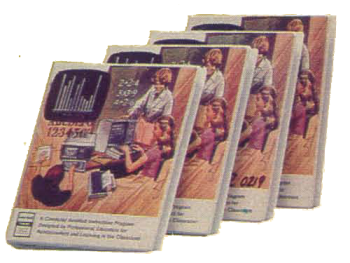
Click to Enlarge
Plots components and sums of student-provided vectors.

Poses graph-related questions or simulations relating to rectilinear motion including position, speed, displacement and acceleration concepts.

Plots and analyzes data pairs input by student.
(Tandy).jpg)
Click to Enlarge
Allows students to practice constructing proofs using nine basic posulates of Euclidean geometry. Developed by a high school geometry tracher and tested extensively in the calssroom. Program works out a proof automatically, and guides and tests construction of student’s proofs. Teacher’s manual includes numerous exercises in Euclidean geometry.
.jpg)
Click to Enlarge
The original K-8 Math Program with added student management features. Monitors promotions and demotions, and allows for teacher review of scores. Starts each student in the appropriate lesson each session. Printer optional.
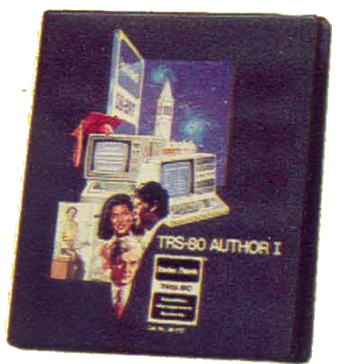
Click to Enlarge
A screen-oriented authoring system that allows teachers to create computer-based lessons. Features full-screen editing, graphics, branching and automatic score-keeping option. Teacher can include a glossary, hints, feedback messages. Printed report includes scores and timings.
(Tandy).jpg)
Click to Enlarge
This mini-authoring system makes it easy to create, edit, store and give multiple-choice tests in any subject area. Allows up to 40 questions with four choices per question.
(Tandy).jpg)
Click to Enlarge
A game of elementary deduction which allows you the opportunity to match specific criminals to specific crimes. All of the crimes were committed during the Great Train Robbery in England. After more than a year of searching, Scotland Yard has rounded up seven suspects for the vfour crimes committed – assault, felony theft, arson, and illegal parking. You have up to eight trial (after which the statute of limitations runs out) to match the right criminal to the right crime.
(Tandy).jpg)
Click to Enlarge
Fast paced fun for 4K Level II.
(Radio-Shack).jpg)
Click to Enlarge
Checkers, Hammurabi, Draw, Star Pilot, Random Tic-Tac-Toe, Space Taxi
(Tandy).jpg)
Click to Enlarge
Craps, Keno, Slot Machine, Roulette, Wheel of Fortune and Baccarat
(Personal-Software).jpg)
Click to Enlarge
3 levels of difficulty. For beginning or advanced players.
(Tandy).jpg)
Click to Enlarge
Five octave range with sharps and flats, whole, half, quarter, and eighth notes.
(Tandy)[26-1903].jpg)
Click to Enlarge
Draw and play back animated “movies” on TRS-80 video monitor

Create 1-inch high letters moving up your TRS-80 screen. 13 characters per line.
(Tandy).jpg)
Click to Enlarge
Shoot ’em down in “real time” with your laser cannong.
(Tandy).jpg)
Click to Enlarge
Command a space ship via TRS-80 keyboard. Destroy the aliens before they destroy you!
(Tandy)[RS26-1907].jpg)
Click to Enlarge
Competition “forced jump” game with two levels of skill.
(Tandy).jpg)
Click to Enlarge
Discuss your problems with “Eliza.”
(Software-Concepts).jpg)
Click to Enlarge
A special interactive story – and you can be the hero! Make decisions that help determine the outcome – it’s different everytime! But But be careful of making the wrong choice.
(Tandy)[26-1919].jpg)
Click to Enlarge
An Interactive adventure game for youngsters.
(Tandy).jpg)
Click to Enlarge
Explore a planet and fight off aliens!

Includes two games! Destroy wave alter wave of alien space ships in Cosmic Fighter. Avoid the space rocks and rescue the stranded astronauts on a distant planet in Meteor Mission 2. Optional sound effects.
(Tandy).jpg)
Click to Enlarge
Includes two games! Recover the stolen fuel cells and return them to earth in Defense Command. Escort your supply cruisers through enemy zones in Stellar Escort. Optional sound effects.
(Sega-Cornsoft)-[a].jpg)
Click to Enlarge
A licensed version of the original arcade game. Get your frogs safely across the road, then guide them to their lily pads on the other side of the river. Optional computer-generated music requires mini-amplifier.
(Cogito)[26-1956].jpg)
Click to Enlarge
Bring the popular arcade challenge home to your TRS-80. Advance from “Rookie Pilot” to “Combat Ace Pilot” as you enter the floating fortress, destroy enemy defenses, and finally defeat the mighty robot, Zaxxon. Add an optional amplifier for great sound effects.
(Tandy).jpg)
Click to Enlarge
Displays memory in 128 or 256 byte full-screen mode. Displays Z-80 registers. Also allows modifications to RAM and registers. Includes single-step execution of programs and break-point interruption of execution.
(Radio-Shack)[600-DPI].jpg)
Click to Enlarge
Machine language monitor. For advanced programmers

Standard Zilog Mnemonics for assembly language combined with the convenience of a text editor. For advanced programmers. Cassette only.

Self-paced course teaches Level I BASIC for TRS-80. 4 tapes
(Tandy).jpg)
Click to Enlarge
Renumber all or part of BASIC programs
(Tandy)[26-2005].jpg)
Click to Enlarge
4 cassettes introducing TRS-80 Level II BASIC
(Tandy)[26-2006].jpg)
Click to Enlarge
Interactive self-paced course on advanced Level II BASIC. 4 tapes.
(Radio-Shack).jpg)
Click to Enlarge
A self-paced course in Disk BASIC covering DOS commands, random and sequential files, all disk additions, and Level II BASIC.
(Tandy).jpg)
Click to Enlarge
Includes manual with Z-80 instruction set. Editor features automatic line numbering, single-letter commands, optional parameters, global search. Assembler features single-letter commands.
(Tandy)[26-2017].jpg)
Click to Enlarge
A self-contained course in Z-80 machine-language programming. Features 27 lessons with examples and exerciuses.
(Radio-Shack).jpg)
Click to Enlarge
Great introduction to this structured programming language (fixed point, non-array version). Includes sample programs to get you started.

Create beautiful graphics with easy-to-use BASIC commands. Requires graphics-mode printer.

Textbook with exercises.
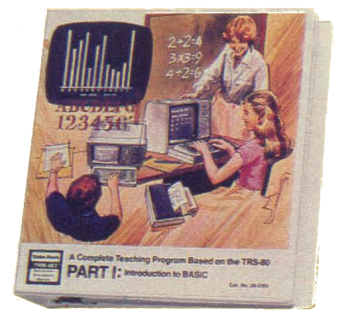
Click to Enlarge
Discusses branching, graphics, subroutines, more.

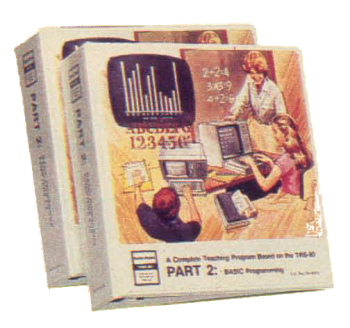
Click to Enlarge
Arrays, memory management. string manipulation, variables, more.

INKEY$, ASCII set, graphics, cassette data files, more.


Library and utility commands, troubleshooting, error messages, more.

.jpg)
Click to Enlarge
Generates worksheets and answer sheets from K-8 Math lessons. Teacher can print multiple copies of identical worksheek or worksheets with different problems at the same difficulty level. Worksheets can be saved on disk for later use or editing. Line printer required.

Macro-assembler, linking loader, editor, cross-reference.

Explores fundamentals through 14 investigations. Graphs and computes areas of functions.
-PO.png)
Click to Enlarge
25-lesson practice course to help students develop speed and accuracy in entry of numeric data using a 10-key pad. Printer optional.

Generates problems with emphasis on straight lines and conic sections.

Six laboratory experiment simulations on Kinetic Theory, Charles’ Law, Boyle’s Law, Titration, Conductivity and Solubility. Students control variables in experiments in order to see changing results. Each package includes an instructor’s manual and 25 student experiment books.

Definitions, examples, and exercises on constructive or computational aspects of number theory concepts.

Generates problems related tos imple matrix algebra.

Practice in coefficient and equation recognition, discriminant evaluation, type of roots, more.

For use with TRS-80 Chemistry Lab, Vol. I

Training course designed to help educators create their own lessons using TRS-80 AUTHOR I. Introduces AUTHOR I concepts. Educators are guided through actual lesson creation using text, graphics and special characters.
-PO.png)
Click to Enlarge
Store and analyze scouting information on our opponent’s offense. Designed for high school and college levels, CHAMPS prints a variety of listings, charts and statistical reports. Get answers to specific tendency questions in seconds. Includes ten CHAMPS Scouting Manuals which allow even inexperienced scouts to collect data. Requires 132-column printer.

Presents lessons that have been created using TRS-80 AUTHOR I. Printed report includes scores and timings. Not required if you have TRS-80 Author I).

Package of 10
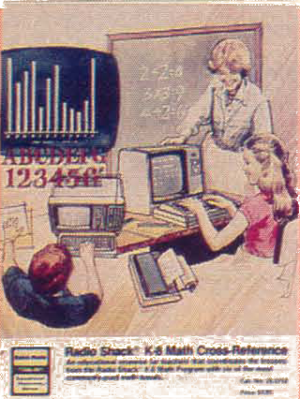
Click to Enlarge
Correlates individual K-8 Math lessons with specific chapters and pages in six major math basis.